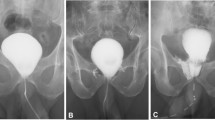Abstract
Objective
To evaluate impact of unidirectional barbed suture on vesicourethral anastomosis (VUA) during robot-assisted radical prostatectomy (RARP) and its comparison with Polyglecaprone-25 suture.
Patients and methods
The study was initiated as pilot study; the participants were grouped into three based on the suture material used for VUA, i.e., monofilament Polyglecaprone-25 (group 1), unidirectional barbed Glycolic acid-trimethylene carbonate (group 2), and bidirectional barbed Polyglycolic acid-polycaprolactone (group 3), respectively. Group 1 was included retrospectively and the latter two prospectively. All cases were operated upon by the same surgeon, proficient in RARP. Patient-demographics, intraoperative and peri-operative data were collected. Our technique of mucosa-to-mucosa VUA is carried out in a choreographed manner using unibarbed suture.
Results
Fifty-five patients were included; 25 each in group 1 and 2. The group 3 was prematurely closed after 5 cases due to perceived inappropriateness of needle characteristics of the suture material. Therefore, the statistical analysis was performed between group 1 and 2 only. Preoperative characteristics including age, PSA, clinical stage, and biopsy grade were similar between the groups. The anastomosis time was significantly less in group 2 (8.4 ± 1.7 min vs. 14.3 ± 4.8 min; P = 0.0001; t test). Postoperative hospital stay was less in group 2 (2.7 ± 1.1 days vs. 1.9 ± 0.8 days; P = 0.023; Mann–Whitney U). None of the patient had presented with urinary leaks, urinary retention, or anastomotic strictures at follow-up of 6 months.
Conclusion
VUA with unidirectional barbed suture is safe and takes less time compared to monofilament suture as repeated cinching; help of assistance and knot tying are not required by virtue of its self-retaining characteristics.


Similar content being viewed by others
References
Menon M, Hemal AK (2004) Vattikuti institute prostatectomy: a technique of robotic radical prostatectomy: experience in more than 1000 cases. J Endourol 18:611–619
Menon M, Hemal AK, Tewari A, Shrivastava A, Bhandari A (2004) The technique of apical dissection of the prostate and urethrovesical anastomosis in robotic radical prostatectomy. BJU Int 93:715–719
Menon M, Tewari A, Peabody JO, Shrivastava A, Kaul S, Bhandari A, Hemal AK (2004) Vattikuti institute prostatectomy, a technique of robotic radical prostatectomy for management of localized carcinoma of the prostate: experience of over 1100 cases. Urol Clin North Am 31:701–717
Hemal AK, Bhandari A, Tewari A, Menon M (2005) The window sign: an aid in laparoscopic and robotic radical prostatectomy. Int Urol Nephrol 37:73–77
Eastham JA, Kattan MW, Rogers E, Goad JR, Ohori M, Boone TB et al (1996) Risk factors for urinary incontinence after radical prostatectomy. J Urol 156:1707–1713
Guillonneau B, Cathelineau X, Doublet JD, Baumert H, Vallancien G (2002) Laparoscopic radical prostatectomy: assessment after 550 procedures. Crit rev onc hemat 43:123–133
Gill IS, Zippe CD (2001) Laparoscopic radical prostatectomy: technique. Urol Clin North Am 28:423–436
Van Velthoven RF, Ahlering TE, Peltier A, Skarecky DW, Clayman RV (2003) Technique for laparoscopic running urethrovesical anastomosis: the single knot method. Urology 61:699–702
Weld KJ, Ames CD, Hruby G, Humphrey PA, Landman J (2006) Evaluation of a novel knotless self anchoring suture material for urinary tract reconstruction. Urology 67:1133–1137
Rashid R, Sartori M, White LE, Villa MT, Yoo SS, Alam M (2007) Breaking strength of barbed polypropylene sutures. Arch Dermatol 143:869–872
Rodeheaver GT, Piñeros-Fernandez A, Salopek LS, et al. (2005) Barbed sutures for wound closure: in vivo wound security, tissue compatibility and cosmesis measurements. Society for biomaterials 30th annual meeting 2005, Transactions: p 232
Einarsson JI, Suzuki Y (2009) Total laparoscopic hysterectomy: 10 steps toward a successful procedure. Rev Obstet Gynecol 2:57–64
Greenberg JA, Clark RM (2009) Advances in suture material for obstetric and gynecologic surgery. Rev Obstet Gynecol 2:146–158
Greenberg JA, Einarsson JI (2008) The use of bidirectional barbed suture in laparoscopic myomectomy and total laparoscopic hysterectomy. J Minim Invas Gynecol 15:621–623
Villa MT, White LE, Murad A, Yoo SS, Walton RL (2008) Barbed sutures: a review of the literature. Pl Reconstr Surg 121:102e–108e
Singh I, Hemal AK (2010) Robotic-assisted radical prostatectomy in 2010. Expert Rev Anticancer Ther 10:671–682
Hemal AK, Menon M (2004) Robotics in urology. Curr Opin Urol 14:89–93
Nguyen MM, Kamoi K, Stein RJ, Aron M, Hafron JM, Turna B et al (2008) Early continence outcomes of posterior musculofascial plate reconstruction during robotic and laparoscopic prostatectomy. BJU Int 101:1135–1139
Tewari A, Jhaveri J, Rao S, Yadav R, Bartsch G, Te A et al (2008) Total reconstruction of the vesico-urethral junction. BJU Int 101:871–877
Menon M, Muhletaler F, Campos M, Peabody JO (2008) Assessment of early continence after reconstruction of the periprostatic tissues in patients undergoing computer assisted (robotic) prostatectomy: results of a 2 group parallel randomized controlled trial. J Urol 180:1018–1023
Moran ME, Marsh C, Perrotti M (2007) Bidirectional-barbed sutured knotless running anastomosis v classic Van Velthoven suturing in a model system. J Endourol 21:1175–1178
Tewari AK, Srivastava A, Sooriakumaran P et al (2010) Use of a novel absorbable barbed plastic surgical suture enables a “self-cinching” technique of vesicourethral anastomosis during robot-assisted prostatectomy and improves anastomotic times. J Endourol 24:1645–1650
Kaul S, Sammon J, Bhandari A et al (2010) A novel method of urethrovesical anastomosis during robot-assisted radical prostatectomy using a unidirectional barbed wound closure device: feasibility study and early outcomes in 51 patients. J Endourol 24:1789–1793
Williams SB, Alemozaffar M, Lei Y et al (2010) Randomized controlled trial of barbed polyglyconate versus polyglactin suture for robot-assisted laparoscopic prostatectomy anastomosis: technique and outcomes. Eur Urol 58:875–881
Author information
Authors and Affiliations
Corresponding author
Rights and permissions
About this article
Cite this article
Hemal, A.K., Agarwal, M.M. & Babbar, P. Impact of newer unidirectional and bidirectional barbed suture on vesicourethral anastomosis during robot-assisted radical prostatectomy and its comparison with polyglecaprone-25 suture: an initial experience. Int Urol Nephrol 44, 125–132 (2012). https://doi.org/10.1007/s11255-011-9967-0
Received:
Accepted:
Published:
Issue Date:
DOI: https://doi.org/10.1007/s11255-011-9967-0




